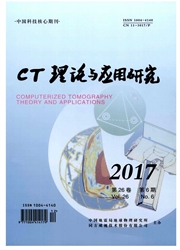

 中文摘要:
中文摘要:
在计算机断层成像(CT)、磁共振成像(MRI)及电子顺磁共振成像(EPRI)中,反投影滤波(BPF)算法是一种重要的解析式重建算法。BPF算法的一个重要步骤是有限希尔伯特变换。该变换可以从一个有限紧支集信号的有限支撑上的反希尔伯特变换恢复该信号。两种简单而实用的实现方法被提出,以分别服务CT和MRI或EPRI,用三种典型的信号验证这两种实现方法。一个抛物线函数被用在数值实验中验证边界稳定性。实验结果表明:这两种方法用比有限紧支集信号的支撑间隔稍大的合适的间隔,可以得到足够精确的结果;不包含定积分的实现方法不稳定,即对间隔的选取敏感,而包含定积分的实现方法是稳定的,且只要求间隔稍稍大于待求有限紧支集信号的支撑间隔,即可实现精确变换。包含定积分的实现方法适合于CT重建;不包含定积分的实现方法适合于MRI和EPRI.
 英文摘要:
英文摘要:
Backprojection filtration(BPF) algorithms are important analytical reconstruction algorithms in Computed Tomography(CT), Magnetic Resonance Imaging(MRI) and Electron Paramagnetic Resonance Imaging(EPRI). An important step in the BPF algorithm is the finite Hilbert transform(FHT), which allows recovery of a compactly supported function from its inverse Hilbert transform using only a finite interval. Two simple and practical implementation methods were proposed to serve for CT and EPRI, respectively. Numerical experiments were made on three classical functions to verify the two implementation methods. The boundary stability analysis was given by numerical experiments on a parabola function. The results show that the two methods can get enough exact results using an appropriate interval bigger than the supporting interval of the compactly supported function and that the method not including definite integration is not stable and is sensitive to the change of the interval. However the method including definite integration is very stable and can get an exact result just using a small interval that is a little bigger than the supporting interval. The method including definite integration is fit for CT and the method not including definite integration is fit for MRI and EPRI.
 同期刊论文项目
同期刊论文项目
 同项目期刊论文
同项目期刊论文
 期刊信息
期刊信息
